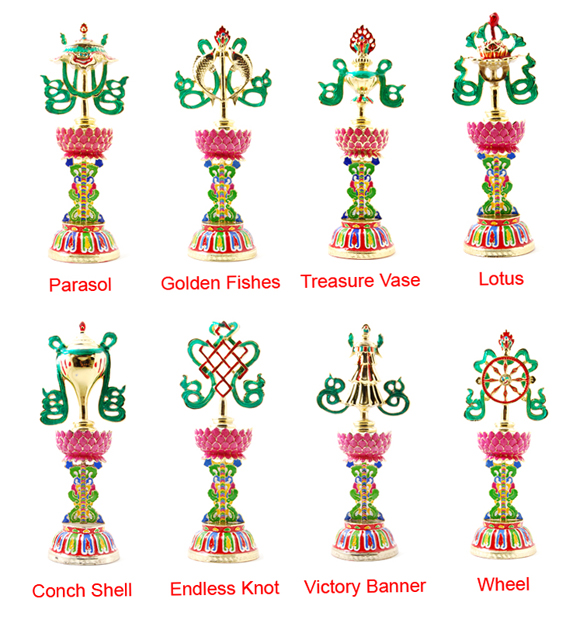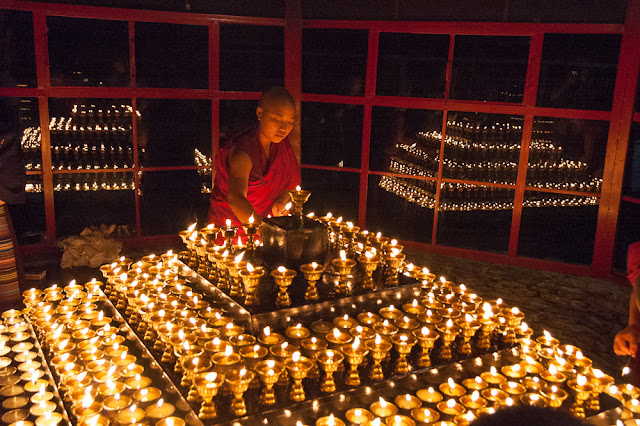"If you wish to come and be born in my realm, you must always recite my sacred mantra again and again, you must always keep this thought in mind without letting up, and thus you will succeed in coming to be born in my realm.
If my 48 Great Vows do not come to pass, may I not attain my enlightenment".
Amithabha Buddha 48 Great VowsIf my 48 Great Vows do not come to pass, may I not attain my enlightenment".
The Tibetan word of "Dewachen" literally means the celestial mandala or the Amithabha Buddha pure land, and in Sanskrit name is Sukhavati and in Chinese is 西方極樂淨土. The Sacred Pure Land of Amitabha Buddha was delivered by Shakyamuni Buddha at the Vulture Peak in Rajagriha, India.
Amithabha Buddha 南無阿彌陀佛 he is represents the Padma Lotus family. Amitābha means "Infinite Light" so Amitābha is also called "The Buddha of Immeasurable Life and Light".
He is the Buddha of the West direction.
His Mantra is " OM AMI DEVA HRIH "
His Mantra in Chinese is " 南無阿彌陀佛 "
His syllable is "Hrih"
His color is in red.
His element is signifies or represents fire
His symbolism is the Lotus.
His wisdom is signifies as Inquisitive and the wisdom of observation.
His hands mudras are signify as Meditation.
He is symbolizes or associated with summer season.
His consort is Pandara.
His Dhyani Bodhisattva is Avalokiteshvara.
His Pure Land is called Sukhavati, the Western Pure Land.
The 48 Great Vows of Amitabha Buddha
When Buddha Amitabha was still a Bodhisattva, by the name of Dharmakara, He had made the following 48 Bodhisattva vows:-
- If, when I attain Buddhahood, should there be in my land a hell, a realm of hungry spirits or a realm of animals, may I not attain perfect Enlightenment.
- If, when I attain Buddhahood, humans and devas in my land should after death fall again into the three evil realms, may I not attain perfect Enlightenment.
- If, when I attain Buddhahood, humans and devas in my land should not all be the colour of pure gold, may I not attain perfect Enlightenment.
- If, when I attain Buddhahood, humans and devas in my land should not all be of one appearance, and should there be any difference in beauty, may I not attain perfect Enlightenment.
- If, when I attain Buddhahood, humans and devas in my land should not remember all their previous lives, not knowing at least the events which occurred during the previous hundred thousand kotis of nayutas of kalpas, may I not attain perfect Enlightenment.
- If, when I attain Buddhahood, humans and devas in my land should not possess the divine eye of seeing at least a hundred thousand kotis of nayutas of Buddha-lands, may I not attain perfect Enlightenment.
- If, when I attain Buddhahood, humans and devas in my land should not possess the divine ear of hearing the teachings of at least a hundred thousand kotis of nayutas of Buddhas and should not remember all of them, may I not attain perfect Enlightenment.
- If, when I attain Buddhahood, humans and devas in my land should not possess the faculty of knowing the thoughts of others, even those of all sentient beings living in a hundred thousand kotis of nayutas of Buddha-lands, may I not attain perfect Enlightenment.
- If, when I attain Buddhahood, humans and devas in my land should not possess the supernatural power of travelling anywhere in one instant, even beyond a hundred thousand kotis of nayutas of Buddha-lands, may I not attain perfect Enlightenment.
- If, when I attain Buddhahood, humans and devas in my land should give rise to thoughts of self-attachment, may I not attain perfect Enlightenment.
- If, when I attain Buddhahood, humans and devas in my land should not dwell in the Definitely Assured State and unfailingly reach Nirvana, may I not attain perfect Enlightenment.
- If, when I attain Buddhahood, my light should be limited, unable to illuminate even a hundred thousand kotis of nayutas of Buddha-lands, may I not attain perfect Enlightenment.
- If, when I attain Buddhahood, my life-span should be limited, even to the extent of a hundred thousand kotis of nayutas of kalpas, may I not attain perfect Enlightenment.
- If, when I attain Buddhahood, the number of the shravakas in my land could be known, even if all the beings and pratyekabuddhas living in this universe of a thousand million worlds should count them during a hundred thousand kalpas, may I not attain perfect Enlightenment.
- If, when I attain Buddhahood, humans and devas in my land should have limited life-spans, except when they wish to shorten them in accordance with their previous vows, may I not attain perfect Enlightenment.
- If, when I attain Buddhahood, humans and devas in my land should even hear of any wrongdoing, may I not attain perfect Enlightenment.
- If, when I attain Buddhahood, innumerable Buddhas in the land of the ten directions should not all praise and glorify my Name, may I not attain perfect Enlightenment.
- If, when I attain Buddhahood, sentient beings in the lands of the ten directions who sincerely and joyfully entrust themselves to me, aspire to be born in my land, and call my Name even ten times, should not be born there, may I not attain perfect Enlightenment. Excluded, however, are those who commit the five gravest offences and abuse the right Dharma.
- If, when I attain Buddhahood, sentient beings in the lands of the ten directions, who awaken aspiration for Enlightenment, do various meritorious deeds and sincerely desire to be born in my land, should not, at their death, see me appear before them surrounded by a multitude of sages, may I not attain perfect Enlightenment.
- If, when I attain Buddhahood, sentient beings in the lands of the ten directions who, having heard my Name, concentrate their thoughts on my land, do various meritorious deeds and sincerely transfer their merits towards my land with a desire to be born there, should not eventually fulfil their aspiration, may I not attain perfect Enlightenment.
- If, when I attain Buddhahood, humans and devas in my land should not all be endowed with the thirty-two physical characteristics of a Great Man, may I not attain perfect Enlightenment.
- If, when I attain Buddhahood, bodhisattvas in the Buddha-lands of other directions who visit my land should not ultimately and unfailingly reach the Stage of Becoming a Buddha after One More Life, may I not attain perfect Enlightenment. Excepted are those who wish to teach and guide sentient beings in accordance with their original vows. For they wear the armour of great vows, accumulate merits, deliver all beings from birth-and-death, visit Buddha-lands to perform the bodhisattva practices, make offerings to Buddhas, Tathagatas, throughout the ten directions, enlighten uncountable sentient beings as numerous as the sands of the River Ganges, and establish them in the highest, perfect Enlightenment. Such bodhisattvas transcend the course of practice of the ordinary bodhisattva stages and actually cultivate the virtues of Samantabhadra.
- If, when I attain Buddhahood, bodhisattvas in my land, who would make offerings to Buddhas through my divine power, should not be able to reach immeasurable and innumerable kotis of nayutas of Buddha-lands in the short time it takes to eat a meal, may I not attain perfect Enlightenment.
- If, when I attain Buddhahood, bodhisattvas in my land should not be able, as they wish, to perform meritorious acts of worshipping the Buddhas with the offerings of their choice, may I not attain perfect Enlightenment.












































